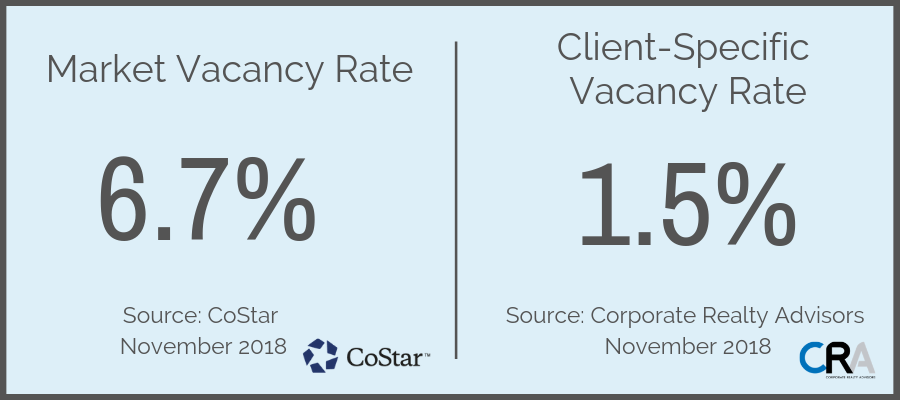The Value of Vacancy Rates: True Opportunity or Fool’s Gold?
By Brian Kelly on Mar 22, 2021

The “vacancy rate” – a common but often misunderstood term in commercial real estate — is a figure expressed as a percentage that indicates current available space relative to the total space in each market based on the type of building (office, warehouse, flex, or retail) you are seeking.
It is often a key market indicator used to measure current commercial real estate conditions in a given geographic area, as well as, major and secondary markets.
Depending on whether you are searching for industrial, office, flex, or retail space, you can typically refer to the vacancy rate for the type of building you are seeking to provide you with a general overview of space availability. However, commercial real estate insiders, especially skilled tenant representatives, know that while the vacancy rate may be a good starting point to get a basic idea of current marketplace, it’s a cursory figure that habitually doesn’t properly reflect the reality of your market. Experienced tenant representatives consider the overall marketplace vacancy rate, and drill down on the true numbers on your behalf to determine your vacancy rate. Your vacancy rate is the precise number you are looking for in order to reduce occupancy costs.
Once you start filtering your options for your specific needs, the detailed criteria pertaining to your unique requirement, the true vacancy rate — changes dramatically.
Some of the potential criteria that can affect your unique industrial vacancy rate:
- Your timing relative to available space in the market;
- Length of term desired;
- Square footage needed;
- Ceiling height (often referred to as “clear height”);
- Number of available dock doors and drive in (“grade level”) doors;
- Restrictions based on the type of product being stored (e.g., hazardous materials, freezer/cooler needs, etc.);
- Trailer storage availability;
- Flexibility in terms of ability to expand beyond the current building’s size (i.e., the availability of adjacent land should your company anticipate future growth)
CRA Client Example:
We recently worked with a client that was searching for warehouse space in El Paso, TX. As shown below, the vacancy rate listed in that market for industrial space was 6.7%; however, once we conducted research to narrow our search of available space based on their unique criteria, the adjusted rate was much closer to 1.5%.

That’s a vast difference, that measurably effects your project timeline and occupancy costs. Being equipped with real-time market data helped us determine the best way to manage the client’s objectives, plan the appropriate timeline to leverage all the options available in the market, and develop a true occupancy timeline and occupancy budget based on available space.
Timing is a critical component for any negotiation, and even more vital when the Client-Specific Vacancy Rates fall under 5%.
Knowing your true vacancy rate can help you determine the following:
- How to plan strategically in certain markets
- How far out in advance you need to be working on negotiations for a renewal, if existing location, and trying to leverage appropriate options available in the market for:
- Other existing buildings
- Tenants that may be vacating in the next 6 – 12 months
- Buildings under construction
- Potential build-to-suit sites or pad-ready development sites
If you are not giving yourself enough time, you will limit your ability to review options that would have otherwise been potential candidates.
Taking a proactive approach will help ensure you can leverage the appropriate timeline for your real estate requirement and make the most informed decision for your company.
By asking the right questions and presenting a summary of all pertinent findings, the experienced and resourceful professionals at CRA are always ready with valuable market insights to help you negotiate the best, data-driven real estate solution possible.
Need help evaluating the market?




